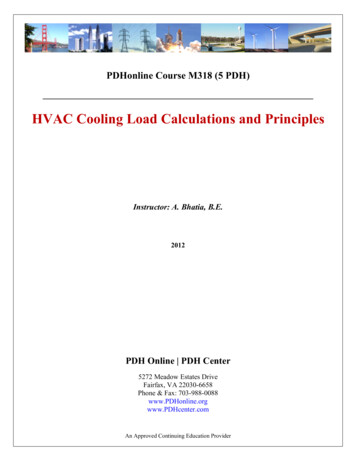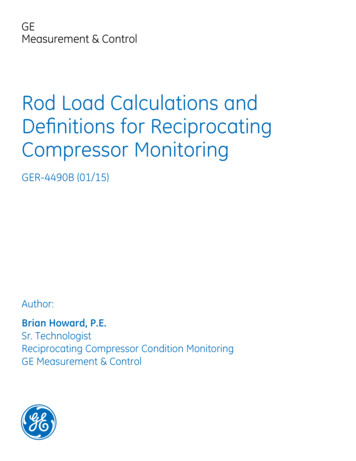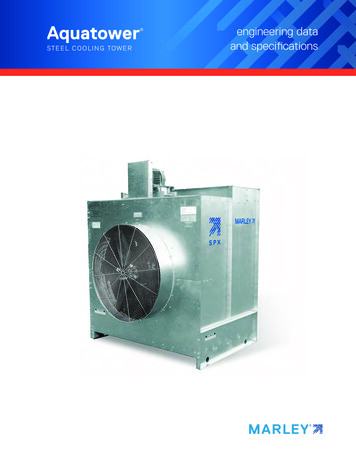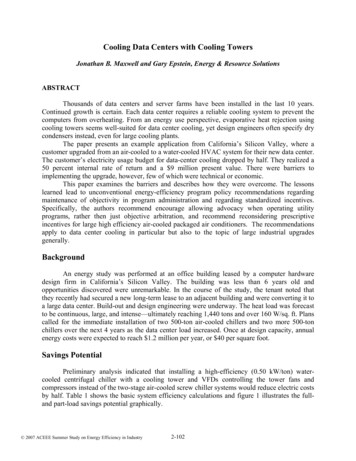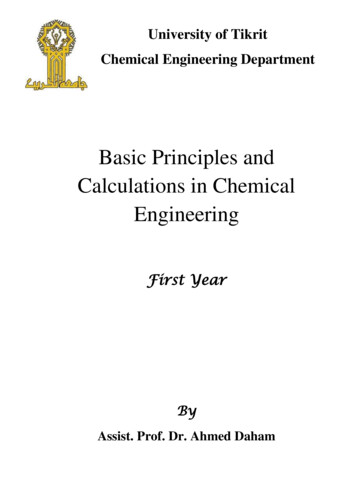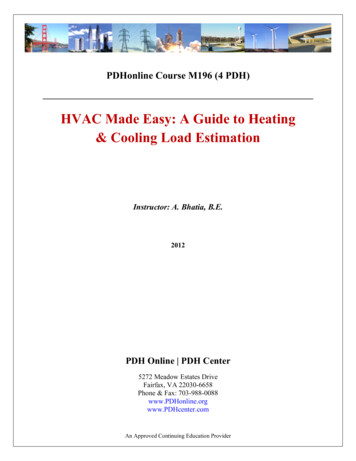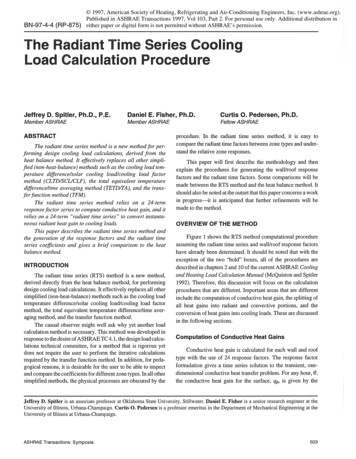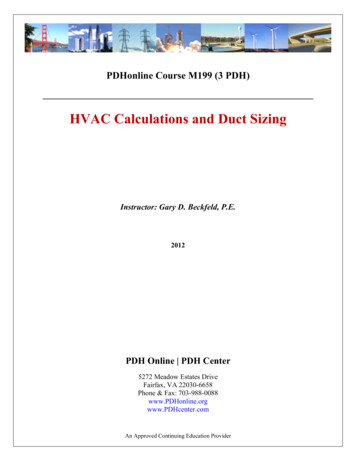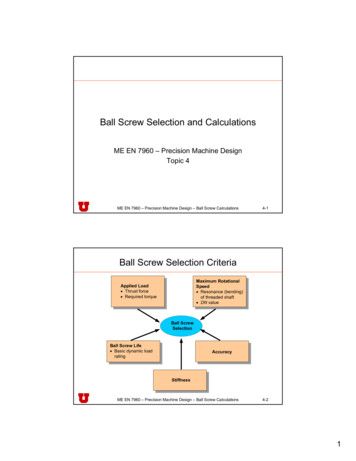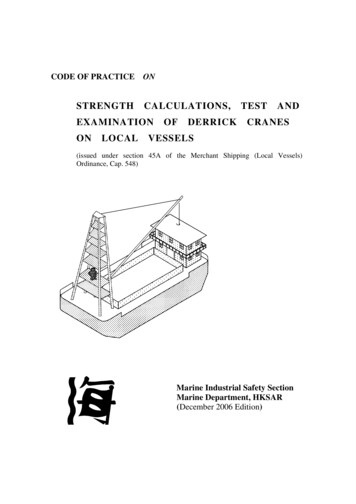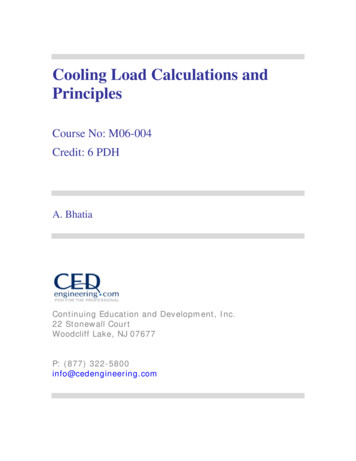
Transcription
Cooling Load Calculations andPrinciplesCourse No: M06-004Credit: 6 PDHA. BhatiaContinuing Education and Development, Inc.22 Stonewall CourtWoodcliff Lake, NJ 07677P: (877) 322-5800info@cedengineering.com
HVAC COOLING LOAD CALCULATIONS AND PRINCIPLESTABLE OF CONTENTS1.0OBJECTIVE . 22.0TERMINOLOGY . 23.0SIZING YOUR AIR-CONDITIONING SYSTEM . 43.14.0HEATING LOAD V/S COOLING LOAD CALCULATIONS. 5HEAT FLOW RATES. 54.1SPACE HEAT GAIN. 64.2SPACE HEAT GAIN V/S COOLING LOAD (HEAT STORAGE EFFECT) . 74.3SPACE COOLING V/S COOLING LOAD (COIL). 85.0COMPONENTS OF COOLING LOAD . 86.0COOLING LOAD CALCULATION METHOD . 96.17.08.0DESIGN INFORMATION . 107.1OUTDOOR DESIGN WEATHER CONDITIONS . 107.2INDOOR DESIGN CONDITIONS AND THERMAL COMFORT. 127.3INDOOR AIR QUALITY AND OUTDOOR AIR REQUIREMENTS. 137.4BUILDING PRESSURIZATION . 137.5BUILDING CHARACTERISTICS . 147.6OPERATING SCHEDULES . 14COOLING LOAD METHODOLOGY – CONSIDERATIONS & ASSUMPTIONS . 148.19.0ACCURACY AND RELIABILITY OF VARIOUS CALCULATION METHODS. 9THERMAL ZONING . 15CLTD/SCL/CLF METHOD OF LOAD CALCULATION (ASHRAE FUNDAMENTALS 1997). 169.1EXTERNAL COOLING LOAD. 169.2INTERNAL COOLING LOADS. 259.3HEAT GAIN FROM MISCELLANEOUS SOURCES . 3010.0SUPPLY AIR CALCULATIONS . 3211.0EXAMPLE . 3312.013.011.1COOLING LOAD EXAMPLE IN US UNITS . 3311.2COOLING LOAD EXAMPLE IN METRIC UNITS . 53COMPUTER PROGRAMS. 5712.1ELITE CHVAC. 5712.2TRACE 700 . 59REFERENCES . 61Page 1 of 61
HVAC COOLING LOAD CALCULATIONS AND PRINCIPLES1.0OBJECTIVECooling load calculations may be used to accomplish one or more of the following objectives:a) Provide information for equipment selection, system sizing and system design.b) Provide data for evaluating the optimum possibilities for load reduction.c) Permit analysis of partial loads as required for system design, operation and control.This course provides a procedure for preparing a manual calculation for cooling load. A number of publishedmethods, tables and charts from industry handbooks, manufacturer’s engineering data and manufacturer’scatalog data usually provide a good source of design information and criteria in the preparation of the HVAC loadcalculation. It is not the intent of this course to duplicate this information but rather to extract appropriate datafrom these documents as well as provide a direction regarding the proper use or application of such data so thatengineers and designers involved in preparing the calculations can make the appropriate decision and/or applyproper engineering judgment.The course includes two example calculations for better understanding of the subject.2.0TERMINOLOGYCommonly used terms relative to heat transmission and load calculations are defined below in accordance withASHRAE Standard 12-75, Refrigeration Terms and Definitions.Space – is either a volume or a site without a partition or a partitioned room or group of rooms.Room – is an enclosed or partitioned space that is usually treated as single load.Zone – is a space or group of spaces within a building with heating and/or cooling requirements sufficiently similarso that comfort conditions can be maintained throughout by a single controlling device.British thermal unit (Btu) - is the approximate heat required to raise 1 lb. of water 1 deg Fahrenheit, from 590Fto 600F. Air conditioners are rated by the number of British Thermal Units (Btu) of heat they can remove per hour.Another common rating term for air conditioning size is the "ton," which is 12,000 Btu per hour and Watts. Somecountries utilize one unit, more than the others and therefore it is good if you can remember the relationshipbetween BTU/hr, Ton, and Watts. 1 ton is equivalent to 12,000 BTU/hr. and 12,000 BTU/hr is equivalent to 3,516 Watts - or 3.516 kW (kilo-Watts).Cooling Load Temperature Difference (CLTD) – an equivalent temperature difference used for calculating theinstantaneous external cooling load across a wall or roof.Page 2 of 61
HVAC COOLING LOAD CALCULATIONS AND PRINCIPLESSensible Heat Gain – is the energy added to the space by conduction, convection and/or radiation.Latent Heat Gain – is the energy added to the space when moisture is added to the space by means of vaporemitted by the occupants, generated by a process or through air infiltration from outside or adjacent areas.Radiant Heat Gain – the rate at which heat absorbed is by the surfaces enclosing the space and the objectswithin the space.Space Heat Gain – is the rate at which heat enters into and/or is generated within the conditioned spaceduring a given time interval.Space Cooling Load – is the rate at which energy must be removed from a space to maintain a constantspace air temperature.Space Heat Extraction Rate - the rate at which heat is removed from the conditioned space and is equal tothe space cooling load if the room temperature remains constant.Temperature, Dry Bulb – is the temperature of air indicated by a regular thermometer.Temperature, Wet Bulb – is the temperature measured by a thermometer that has a bulb wrapped in wetcloth. The evaporation of water from the thermometer has a cooling effect, so the temperature indicated bythe wet bulb thermometer is less than the temperature indicated by a dry-bulb (normal, unmodified)thermometer. The rate of evaporation from the wet-bulb thermometer depends on the humidity of the air.Evaporation is slower when the air is already full of water vapor. For this reason, the difference in thetemperatures indicated by ordinary dry bulb and wet bulb thermometers gives a measure of atmospherichumidity.Temperature, Dewpoint – is the temperature to which air must be cooled in order to reach saturation or atwhich the condensation of water vapor in a space begins for a given state of humidity and pressure.Relative humidity - describes how far the air is from saturation. It is a useful term for expressing theamount of water vapor when discussing the amount and rate of evaporation. One way to approachsaturation, a relative humidity of 100%, is to cool the air. It is therefore useful to know how much the airneeds to be cooled to reach saturation.Thermal Transmittance or Heat Transfer Coefficient (U-factor) – is the rate of heat flow through a unitarea of building envelope material or assembly, including its boundary films, per unit of temperaturedifference between the inside and outside air. The U-factor is expressed in Btu/ (hr 0F ft2).Thermal Resistance (R) – is the reciprocal of a heat transfer coefficient and is expressed in (hr 0F ft2)/Btu. Forexample, a wall with a U-value of 0.25 would have a resistance value of R 1/U 1/0.25 4.0. The value of R isalso used to represent Thermal Resistivity, the reciprocal of the thermal conductivity.Page 3 of 61
HVAC COOLING LOAD CALCULATIONS AND PRINCIPLES3.0SIZING YOUR AIR-CONDITIONING SYSTEMConcepts and fundamentals of air conditioner sizing is based on heat gain, and/or losses in a building. It isobvious that you will need to remove the amount of heat gain - if it is hot outside. Similarly, you'll need to add inthe heat loss from your space - if outside temperature is cold. In short, heat gain and loss, must be equallybalanced by heat removal, and addition, to get the desired room comfort that we want.The heat gain or heat loss through a building depends on:a. The temperature difference between outside temperature and our desired temperature.b. The type of construction and the amount of insulation is in your ceiling and walls. Let's say, that you havetwo identical buildings, one is build out of glass, and the other out of brick. Of course the one built withglass would require much more heat addition, or removal, compared to the other - given a same day. Thisis because the glass has a high thermal conductivity (U-value) as compared to the brick and alsobecause it is transparent, it allows direct transmission of solar heat.c.How much shade is on your building’s windows, walls, and roof? Two identical buildings with differentorientation with respect to the direction of sun rise and fall will also influence the air conditioner sizing.d. How large is your room? The surface area of the walls. The larger the surface area - the more heat canloose, or gain through it.e. How much air leaks into indoor space from the outside? Infiltration plays a part in determining our airconditioner sizing. Door gaps, cracked windows, chimneys - are the "doorways" for air to enter fromoutside, into your living space.f.The occupants. It takes a lot to cool a town hall full of people.g. Activities and other equipment within a building. Cooking? Hot bath? Gymnasium?h. Amount of lighting in the room. High efficiency lighting fixtures generate less heat.i.How much heat the appliances generate. Number of power equipments such as oven, washing machine,computers, TV inside the space; all contribute to heat.The air conditioner's efficiency, performance, durability, and cost depend on matching its size to the abovefactors. Many designers use a simple square foot method for sizing the air-conditioners. The most common rule ofthumb is to use "1 ton for every 500 square feet of floor area". Such a method is useful in preliminary estimationof the equipment size. The main drawback of rules-of-thumb methods is the presumption that the building designwill not make any difference. Thus the rules for a badly designed building are typically the same as for a gooddesign.It is important to use the correct procedure for estimating heat gain or heat loss. Two groups—the AirConditioning Contractors of America (ACCA) and the American Society of Heating, Refrigerating, and AirConditioning Engineers (ASHRAE)—publish calculation procedures for sizing central air conditioners.Page 4 of 61
HVAC COOLING LOAD CALCULATIONS AND PRINCIPLESReputable air conditioning contractors will use one of these procedures, often performed with the aid of acomputer, to size your new central air conditioner.3.1Heating Load V/s Cooling Load CalculationsAs the name implies, heating load calculations are carried out to estimate the heat l
HVAC COOLING LOAD CALCULATIONS AND PRINCIPLES Sensible Heat Gain – is the energy added to the space by conduction, convection and/or radiation. Latent Heat Gain – is the energy added to the space when moisture is added to the space by means of vapor emitted by the occupants, generated by a process or through air infiltration from outside or adjacent areas.
